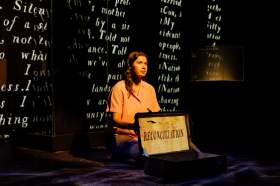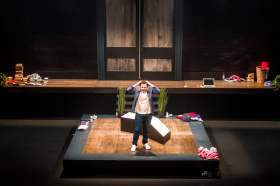In 2018, when Geoffrey Gurrumul Yunupiŋu’s album Djarimirri (Child of the Rainbow) was released – not long after his death in 2017 – his manager and collaborator Michael Hohnen wrote in an article published in The Guardian: ‘It’s […] our attempt at a creative meeting place where both our cultures continually mirror each other and both win out’.
In Buŋgul, Gurrumul’s groundbreaking album is performed by the Melbourne Symphony Orchestra, Yolŋgu songmen and dancers, each element creatively working together – as originally envisioned – to produce a singularly transcendent experience.
Gurrumul’s album is comprised of songs based on stories from his North Arnhem Land homeland (Ngarrpiya – Octopus, Waak – Crow, Marrayarr – Flag, Djapana – Sunset), each introduced with a title slide on a large screen, telling us the moiety (Yirritja or Dhuwa: the two opposite kinship families that make up Yolŋgu culture), clan and language origins of the song. Beginning with Baru (Saltwater Crocodile) in E-Flat Major – two dancers lying prostrate on the large, circular sand-filled stage positioned in front of the orchestra, a stack of smoking bark between them, as another dancer begins painting one of the bodies before him.
Djolin (Musical Instrument) in D Major allows for some fun moments, as one of the dancers mimes a crushing guitar solo, inviting the audience to show their appreciation. The Concertmaster, Veronique Serret, also shares a moment with another of the dancers who ‘plays’ with his prop musical instrument, as they connect and respond across artforms.
Each of Gurrumul’s songs is written in one key, the texture of the song built up through the interplay of rich vocal harmonies, the cadence and tone of the sung language and the orchestral elements: deep percussion and brass working with the lower strings to ground and provide driving rhythm, high strings in fast-paced multi rhythms moving rapidly in pizzicato, sometimes glissandi – the overall effect a textured and complex portrait of place rendered in sound. In Goparu (Tuna Swimming) in B-Flat Major, the rapidly descending repeated motifs on the violins, evoke seawater rushing over fins.
The Yolŋgu dancers’ movements and the striking visuals projected onto the enormous screen at the rear of the stage fill out each portrait – the video projection alternating between spectacular footage depicting the waterways and deserts, beaches, oceans, wetlands and people of North Arnhem Land – Yolŋgu country – and a multi camera capture of the stage in front of us. This allows us to see a full overhead shot of the dancers’ bodies as they lay on stage, close-ups of painted detail on their bodies, their gaze and their movements.
Video projections move seamlessly between these different visuals, complementing the music and adding a deeper layer of cultural meaning to the subject of each song – in effect helping to transport us (sitting in Melbourne’s Hamer Hall on Wurundjeri country) to the country where these songs, stories and dances come from.
The honest truth was my heart was in my throat from go to woah. Bungul is spectacular – a century-defining Australian album by one of Australia’s greatest ever musicians, brought to life by the musicians of the Melbourne Symphony Orchestra and made flesh by the art, dance and song of Gurrumul’s Yolŋgu countrymen.
The Yolŋgu singers accompany Gurrumul’s recorded voice – I had wondered whether his part would be sung by another singer, but instead the songmen add harmonies and complemented his distinctive voice. Songs from Djarimirri (Child of the Rainbow) are bookended by performances from the Yolŋgu songmen and dancers – filling Melbourne’s Hamer Hall as powerfully as the full orchestra had, with voice, digeridoo and clapstick – feeling like both response and contextualisation of Gurrumul’s songs.
Buŋgul is a remarkable experience – and although these songs and stories are transplanted across the country into one of Melbourne’s largest concert venues, as part of a major arts festival, with music performed by a major state orchestra grounded in the Western classical music tradition – the experience is one of harmony and beauty.
Read: Dance review: TANZ, Arts Centre Melbourne, RISING
As intended by Gurrumul and Hohnen – this creative meeting place is where both cultures win out, creating a deeply moving celebration of ancient song and story for our times and for the future.
Buŋgul
Hamer Hall, Melbourne
Music: Geoffrey Gurrumul Yunupiŋu, Erkki Veltheim, and Michael Hohnen
Directors: Don Wininba Ganambarr and Nigel Jamieson
MSO Musical Director and Conductor: Erkki Velheim
Concertmaster: Veronique Serret
Creative Producer: Michael Hohnen
Executive Producer: Anna Reece
Design and Creative Associate: Jacob Nash
Lighting Designer: Mark Howett
Associate Lighting Designer: Chloe Ogilvie
Sound Designer: Steve Francis
Video Design: Mic Gruchy
Cinematographer: Paul Shakeshaft
Performers: Nebbie Burrarrwanga, Robert Burrarrwanga, Mark Guruwiwi, Terence Guruwiwi, Jaimie Yunupingu, Teo Yunupingu, David Yunupingu, Kyle Yunupingu, Nelson Yunupingu
Tickets: $77-$97
Buŋgul (Gurrumul’s Mother’s Buŋgul, Gurrumul’s Grandmother’s Buŋgul, Gurrumul’s Manikay) will be presented by RISING, Arts Centre Melbourne and the Melbourne Symphony Orchestra until 15 June 2023.





